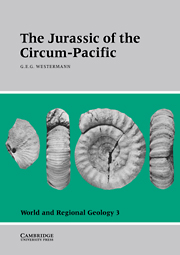Book contents
- Frontmatter
- Contents
- List of contributors
- Preface
- Acknowledgments
- Introduction
- Part I Time scales
- Part II Circum-Pacific base map
- Part III Regional geology and stratigraphy
- Part IV Biochronology
- Part V Biogeography
- 18 Macroflora of eastern Asia and other circum-Pacific areas
- 19 Ostracods and foraminifers of Western Interior North America
- 20 Ostracods of China
- 21 Corals of the circum-Pacific region
- 22 Brachiopods of the circum-Pacific region
- 23 Belemnites of the circum-Pacific region
- 24 Ammonites of the circum-Pacific region
- 25 Fishes of the circum-Pacific region
- 26 Marine reptiles of the circum-Pacific region
- Part VI Climatology and oceanography
- Appendix: Biochronology and atlas with index and guide fossils
- General Index
- Index of Guide- and Indexfossils
21 - Corals of the circum-Pacific region
Published online by Cambridge University Press: 04 August 2010
- Frontmatter
- Contents
- List of contributors
- Preface
- Acknowledgments
- Introduction
- Part I Time scales
- Part II Circum-Pacific base map
- Part III Regional geology and stratigraphy
- Part IV Biochronology
- Part V Biogeography
- 18 Macroflora of eastern Asia and other circum-Pacific areas
- 19 Ostracods and foraminifers of Western Interior North America
- 20 Ostracods of China
- 21 Corals of the circum-Pacific region
- 22 Brachiopods of the circum-Pacific region
- 23 Belemnites of the circum-Pacific region
- 24 Ammonites of the circum-Pacific region
- 25 Fishes of the circum-Pacific region
- 26 Marine reptiles of the circum-Pacific region
- Part VI Climatology and oceanography
- Appendix: Biochronology and atlas with index and guide fossils
- General Index
- Index of Guide- and Indexfossils
Summary
Circum-Pacific Jurassic corals were poorly known until recently. Only two monographs on Japan existed, by Yabe and Sugiyama (1935) on the stromatoporoids and by Eguchi (1951) on the Scleractinia. Rare and insignificant coral occurrences were reported from Indonesia by Tobler (1923) and van Bemmelen (1949).
In the past decade, numerous Jurassic corals have been collected in Canada (T. P. Poulton), western Mexico (T. E. Stump), northern Chile (P. Prinz), the Philippines, western Thailand, and Sarawak (H. Fontaine), Sakhalin and Koryakia (E. V. Krasnov), and Sumatra and Japan (L. Beauvais). Studies of these faunas have contributed to the dating of the source rocks (Lias and Dogger for Canada, Dogger for northern Chile, Dogger and Malm for western Mexico, Sumatra, Sarawak, Japan, and Sakhalin) and to paleogeography (Beauvais and Stump 1976; Krasnov 1983; Beauvais, Bernet-Rolland, and Maurin 1985, 1987).
Lower Jurassic
Liassic corals (Figure 21.1) are very rare throughout the world (Beauvais 1981). In the circum-Pacific area they are presently known only from Canada (Vancouver Island), the lower Amur area (Russia), Argentina, and western Thailand; Argentinean scleractinian studies are in progress (by S. Morsch).
Species distributions indicate connections between western Canada and Morocco, Belgium, and Austria, as well as among Thailand, Belgium, and France. No common species occur between Canada and Thailand.
- Type
- Chapter
- Information
- The Jurassic of the Circum-Pacific , pp. 324 - 327Publisher: Cambridge University PressPrint publication year: 1993



